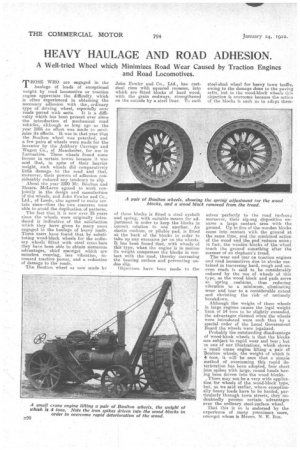HEAVY HAULAGE AND ROAD ADHESION.
Page 16

If you've noticed an error in this article please click here to report it so we can fix it.
A Well-tried Wheel which Minimizes Road Wear Caused by Traction Engines and Road Locomotives.
THOSE WHO are edngaged in the haulage of loads of exceptional weight by road locomotive or traction engine appreciate the difficulty which is often experienced in obtaining the necessary adhesion with the,, ordinary type of driving wheel, especially over roads paved with setts. It, is a difficulty which has been present ever since the introduction of mechanical road vehicles,. although as long ago as the year 1885 an effort was made to minimize its effects: It was in that year that the Boulton wheel was patented, and a few pairs of wheels were made for the inventor by tho .Ashbury Carriage and Wagon Co., of Manchester, for use in Lancashire. These wheels found some favour in certain towns because it was said that, in spite of their heavier weight., such wheels did comparatively little damage to the road and that, inoreover, their powers of adhesion considerably reduced any tendency to slip. About the year 1890 Mr. Boulton and Messrs. McLaren agreed to work conjointly in in the design and manufacture of the wheels, and John Fowler and Co., Ltd., of Leeds,also agreedto make certain sizes—thus the two concerns were able to avoid the duplication of patterns. The fact that it is now over 35 ;years since the wheels were originally introduced is indicative of the satisfaction which they have given to many users engaged in the haulage of heavy loads. These users have found that by substituting wood-block wheels for the ordinary wheels' fitted with steel-cross-bars they have been able to obtain numerous advantages, -chief amongst; which are noiseless running, less vibration, increased tractive power, and a, reduction of damage to the roads.
The Boulton wheel as now made by John Fowler and Co., Ltd., has caststeel rims with squared recesses, into which are fitted blocks of hard wood, with the grain endways, strengthened on the outside by a steel liner. To each of these blocks is fitted a steel. eyebolt and spring,with suitable means for adjustment in order to keep the blocks in correct relation to one another. An elastic cuShion, or pliable pad, is fitted at the back of the blocks in order to take up any excessive jar on the wheels. It has been found that, with wheels of this type, when the engine 'is in motion its weight compresses the blocks in contact with the road, thereby increasing the bearing surface arid preventing undue slip.
Objections have been made to the steel-shod wheel for heavy town traffic, owing to the damage done to the paving setts, but in the wood-block wheels this objection is overcome because the action of the blocks is such as to adapt them
selves perfectly to the road surface; moreover, their zig-zag disposition ensures a largo contact area with the ground. 17p to five of the wooden blocks come into contact with the ground at the same time, and the combined action of the wood and the pad reduces noise; in fact, the woo6n block's of the wheel touch the ground something after the manner of an elephant's tread.
The wear and tear on traction engines and road locomotives due to shocks sustained in traversing hard, rough and uneven roads is said to be considerably reduced by the use of wheels of this type, as the wood block and pads serve as spring cushions thus reducing vibration to a minimum, eliminating wear and tear to a considerable extent and obviating the risk of untimely breakdown.
Although the weight of these wheels in large engines causes the legal weight limit of 14 tons to be slightly exceeded, the advantages claimed when the wheels were introduced were such that by a special order of the Local Government Board the wheels were legalized.
Probably the outstanding disadvantage of wood-block wheels is that the blocks dare subject to rapid wear and tear ; but in one of our illustrations, which shows ,a -small crane engine lifting a pair of 'Boulton wheels, the weight of which is 4. tone, it will be seen that a simple method of overcoming this rapid deterioration has been adopted, four short iron spikes with large, round heads having been driven into the Wood blocks. . There may not be a very wide application for wheels of the wood-block type, but, as we said earlier, where exceptionally-heavy loads have to be hassled, particularly through town streets, they undoubtedly possess certain ad,iantsiges over the ordinary steel-surface wheel.
That this is so is endorsed by the experience of many prominent users, amongst whom is Messrs, N. E. Box.






























